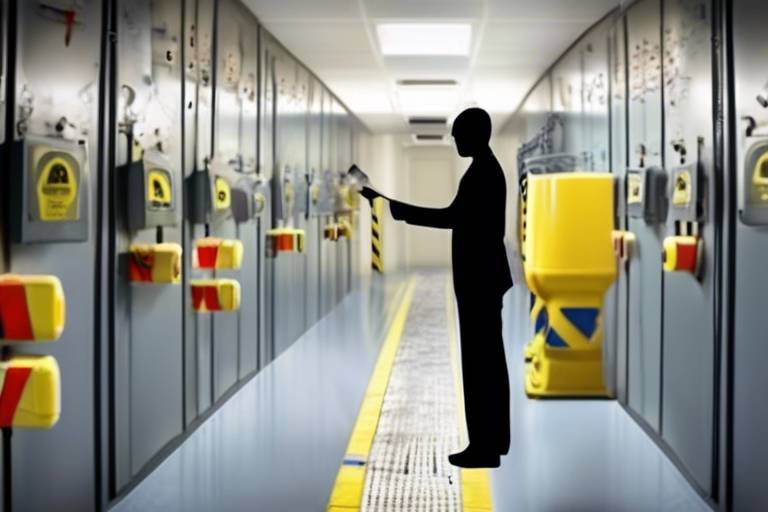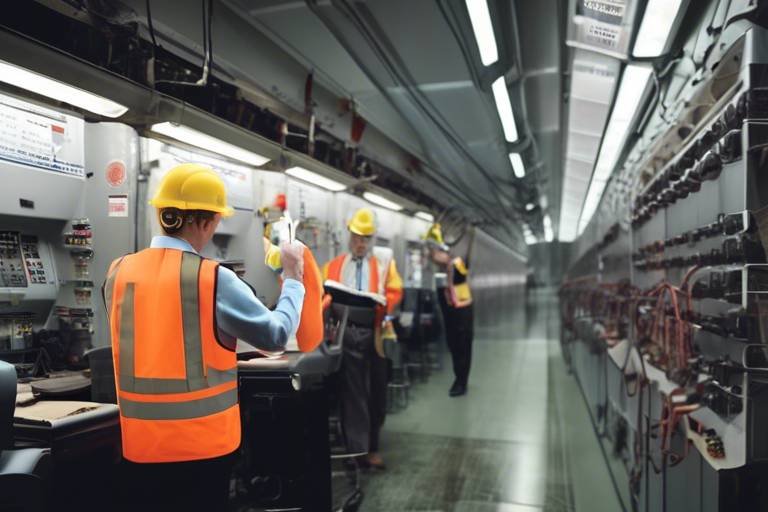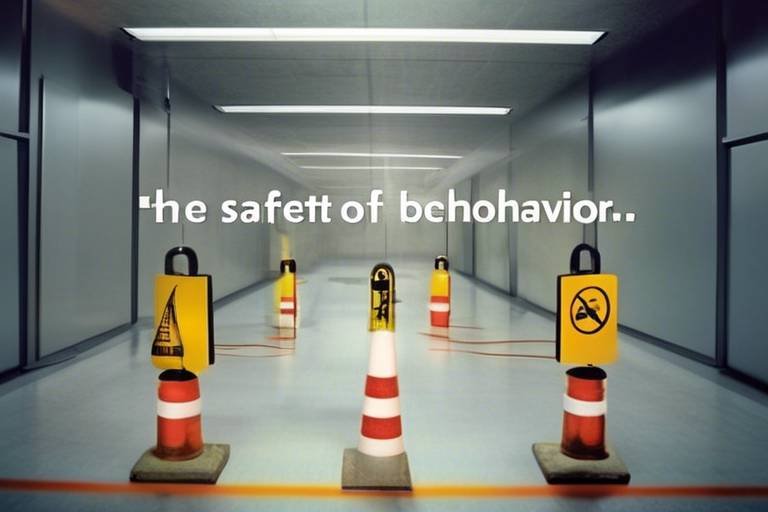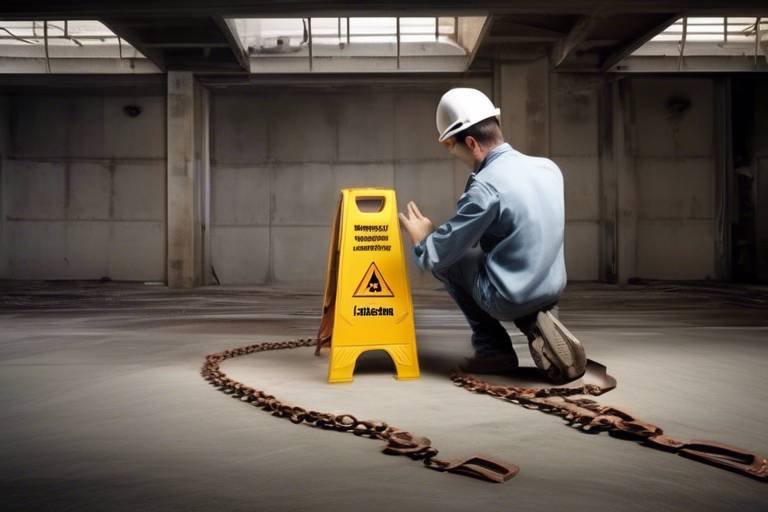Building a Culture of Safety: Understanding Human Behavior
In today's fast-paced world, the importance of safety in the workplace cannot be overstated. It's not just about having the right equipment or protocols in place; it's about fostering a culture where safety is a shared value among all employees. Understanding human behavior is at the core of this endeavor. Why? Because people are the heartbeat of any organization, and their actions—whether intentional or accidental—can significantly impact safety outcomes.
Imagine a workplace where every employee feels empowered to speak up about safety concerns, where safe practices are second nature, and where leadership actively participates in safety initiatives. This is not just a dream; it's a reality that can be achieved by focusing on human behavior. By recognizing the psychological and social factors that influence how individuals act, organizations can create a robust safety culture that not only minimizes risks but also enhances overall productivity.
To build this culture of safety, organizations need to adopt a multi-faceted approach. This includes effective leadership, continuous training, and open communication channels. When leaders model safe behaviors and prioritize safety in their decision-making, they set a powerful example for employees. It's like a ripple effect; when one person takes safety seriously, others are likely to follow suit.
Furthermore, understanding the nuances of human behavior allows organizations to identify potential risks before they escalate into serious incidents. By analyzing behaviors and establishing behavioral safety programs, organizations can recognize safe practices and reinforce them while also addressing at-risk behaviors. This proactive approach not only mitigates hazards but also fosters a sense of community and accountability among employees.
In summary, building a culture of safety requires a deep understanding of human behavior. It involves more than just policies and procedures; it requires engagement, education, and a commitment to continuous improvement. By prioritizing safety as a core value, organizations can create a work environment where everyone feels responsible for their own safety and that of their colleagues. This collective effort is essential for achieving long-term safety goals and ensuring a thriving workplace.

The Role of Leadership in Safety Culture
Effective leadership plays a crucial role in establishing a culture of safety within any organization. It's not just about setting rules or regulations; it's about embodying the values that promote a safe work environment. Leaders have the power to influence employee attitudes positively by modeling safe behaviors. Imagine a ship at sea; the captain's actions dictate the course. If the captain prioritizes safety, the crew is more likely to follow suit. This analogy holds true in the workplace, where leaders must consistently demonstrate their commitment to safety.
To truly foster a safety culture, leaders need to prioritize safety in their organizational values. This means integrating safety into every aspect of the business, from decision-making processes to daily operations. When safety becomes a core value, it transforms from a mere checkbox into a way of life for everyone involved. Leaders should communicate their safety vision clearly and frequently, ensuring that all employees understand its importance. This can be achieved through regular meetings, newsletters, or even digital platforms where safety updates and practices are shared.
Moreover, it's essential for leaders to actively engage with their teams. This can involve participating in safety training sessions, conducting safety audits, or simply being present on the floor to observe and interact with employees. When leaders show that they care about safety, employees are more likely to feel empowered to speak up about hazards or unsafe practices. This open line of communication fosters a sense of ownership and accountability among the workforce.
In addition, leaders should recognize and reward safe behaviors. Positive reinforcement can be a powerful motivator. For instance, implementing a recognition program where employees are acknowledged for their commitment to safety can create a ripple effect throughout the organization. Employees who feel appreciated are more likely to maintain safe practices and encourage their peers to do the same.
In summary, the role of leadership in cultivating a safety culture is multifaceted. It requires a commitment to modeling safe behaviors, integrating safety into organizational values, engaging with employees, and recognizing their efforts. When leaders take these steps, they not only enhance safety practices but also create an environment where employees feel valued and motivated to contribute to a safer workplace.

Understanding Human Behavior in Safety
When it comes to safety in the workplace, understanding human behavior is like having a compass in a dense forest. It guides organizations through the complexities of safety management by highlighting how employees think, feel, and act in various situations. Human behavior significantly impacts safety outcomes; it can either bolster a culture of safety or lead to unfortunate incidents. By analyzing behaviors, organizations can identify risk factors that may compromise safety and implement strategies to mitigate unsafe practices, thus enhancing overall safety.
Think about this: how often do we see someone taking shortcuts or ignoring safety protocols? These actions are often driven by a variety of factors, such as stress, lack of awareness, or even peer pressure. When organizations take the time to understand these underlying motivations, they can tailor their safety programs to address the root causes of unsafe behavior. This proactive approach not only helps in identifying risky behaviors but also encourages a more engaged workforce that feels responsible for their own safety and that of their colleagues.
One effective way to gain insights into human behavior is through the implementation of behavioral safety programs. These programs focus on recognizing and reinforcing safe behaviors while addressing at-risk actions through positive feedback and training. By creating an environment where safe practices are celebrated, organizations can shift the culture towards safety. For example, when employees see their peers being acknowledged for following safety protocols, it creates a ripple effect, encouraging others to do the same.
Additionally, ongoing training and education are vital in promoting safe behaviors. Regular workshops and seminars equip employees with the knowledge and skills necessary to recognize hazards and respond appropriately. It's not just about telling employees what to do; it's about empowering them with the tools they need to make informed decisions in real-time. This kind of empowerment fosters a sense of ownership and accountability, which is essential for a robust safety culture.
Another critical element in understanding human behavior in safety is establishing effective feedback mechanisms. When employees feel comfortable communicating safety concerns and suggestions, it fosters an open dialogue that enhances the overall safety culture. This open communication allows for the identification of potential hazards that may not have been previously considered, creating a more comprehensive safety strategy.
In conclusion, understanding human behavior in safety is not just about compliance; it's about creating a culture where safety is a shared value. By analyzing behaviors, implementing effective training, and fostering open communication, organizations can significantly reduce risks and enhance safety outcomes. Remember, a culture of safety begins with understanding the people who make it possible.
- What are behavioral safety programs? Behavioral safety programs are initiatives designed to encourage safe behaviors among employees by recognizing and reinforcing positive actions while addressing at-risk behaviors through feedback and training.
- How can organizations effectively train their employees on safety? Organizations can conduct regular workshops, seminars, and hands-on training sessions to equip employees with the necessary skills to recognize and respond to hazards effectively.
- Why is feedback important in safety culture? Feedback is crucial as it promotes open communication, allowing employees to voice safety concerns and suggestions, which enhances collective responsibility for safety.

Behavioral Safety Programs
Behavioral Safety Programs are essential in shaping a culture where safety is prioritized and practiced daily. These programs are not just about rules and regulations; they are fundamentally about understanding and modifying human behavior to create a safer workplace. Think of it as a journey where employees are not merely taught what to do but are engaged in a process that encourages them to take ownership of their safety practices. By focusing on recognition and reinforcement of safe behaviors, organizations can cultivate an environment where safety becomes second nature.
One of the key aspects of these programs is the emphasis on positive feedback. Instead of solely pointing out what went wrong, organizations can motivate employees by acknowledging when they observe safe practices. This approach not only boosts morale but also encourages others to follow suit. Imagine a scenario where an employee notices a colleague wearing their personal protective equipment (PPE) correctly. A simple acknowledgment of that behavior can create a ripple effect, inspiring others to adopt similar practices.
Moreover, addressing at-risk actions through constructive feedback is crucial. This isn’t about reprimanding employees; instead, it’s about fostering an environment where individuals feel comfortable discussing their mistakes and learning from them. For instance, if someone forgets to secure a ladder properly, rather than facing criticism, they could be guided through a discussion about the potential risks and how to prevent them in the future. This method not only improves individual behavior but also strengthens team dynamics.
To implement an effective Behavioral Safety Program, organizations can consider the following components:
- Observation and Feedback: Regularly observe work practices and provide immediate feedback to reinforce safe behaviors.
- Training Sessions: Conduct workshops that focus on identifying unsafe behaviors and the importance of safety protocols.
- Involvement: Encourage employees to participate in safety committees or discussions, allowing them to voice their concerns and suggestions.
In conclusion, Behavioral Safety Programs are a vital part of fostering a culture of safety. They shift the focus from merely compliance to a proactive engagement with safety practices. By recognizing safe behaviors and addressing at-risk actions through positive reinforcement, organizations can create a workplace where safety is not just a priority but a shared value among all employees.
Q1: What are Behavioral Safety Programs?
A1: Behavioral Safety Programs are initiatives designed to promote safe behaviors among employees by recognizing and reinforcing positive actions while addressing at-risk behaviors through constructive feedback.
Q2: How do these programs impact workplace safety?
A2: By focusing on human behavior, these programs help create a proactive safety culture where employees feel responsible for their own safety and that of their colleagues, ultimately reducing accidents and incidents.
Q3: What role does feedback play in these programs?
A3: Feedback is crucial as it reinforces safe behaviors and provides opportunities for learning from mistakes, fostering an environment where employees feel valued and engaged in safety practices.

Training and Education
When it comes to fostering a culture of safety, are not just important—they're absolutely essential. Imagine a ship sailing through stormy seas without a captain who knows how to navigate. That’s what a workplace without proper safety training is like. Employees need to be equipped with the right knowledge and skills to recognize hazards and respond appropriately. This isn't just about compliance; it's about empowering individuals to make informed decisions that can save lives.
Regular workshops and seminars serve as the backbone of any effective safety training program. These sessions should cover a range of topics, from understanding personal protective equipment (PPE) to emergency response protocols. For example, a session might include:
- Identifying Hazards: Teaching employees how to spot potential dangers in their work environment.
- Safe Work Practices: Training on how to perform tasks safely, minimizing the risk of injury.
- Emergency Procedures: Providing clear guidelines on what to do in case of an emergency.
But let’s not stop there! The most effective training programs are those that are interactive and engaging. Think about it: would you remember a dry lecture on safety protocols, or would a hands-on workshop where you practice scenarios stick with you longer? Incorporating simulations and role-playing exercises can make a world of difference. For instance, conducting mock drills can prepare employees for real-life situations, ensuring they know exactly how to react when the pressure is on.
Moreover, ongoing training is crucial. Safety isn’t a one-time event; it’s a continuous process. Organizations should establish a schedule for refresher courses and updates on new safety regulations. This ensures that employees stay informed about the latest safety practices and technologies. By fostering a culture of continuous learning, organizations can help employees feel more confident in their ability to handle safety issues as they arise.
In addition to formal training, creating a culture of safety also means encouraging informal learning. This can be achieved by:
- Peer-to-Peer Learning: Employees can share experiences and lessons learned from past incidents.
- Mentorship Programs: Pairing less experienced workers with seasoned veterans can enhance knowledge transfer.
- Safety Committees: Involving employees in safety discussions can provide valuable insights and foster a sense of ownership.
Ultimately, the goal of training and education in safety is to create a workforce that is not only knowledgeable but also actively engaged in promoting a safe work environment. When employees feel competent and confident in their abilities, they are more likely to take initiative in addressing safety concerns and advocating for best practices. In this way, training and education become the driving forces behind a robust safety culture, one that prioritizes the well-being of everyone involved.
Q: How often should safety training be conducted?
A: Safety training should be conducted regularly, with refresher courses at least annually, and more frequently for high-risk environments.
Q: What topics should be covered in safety training?
A: Training should cover hazard identification, safe work practices, emergency procedures, and any specific risks related to the job.
Q: How can I make safety training more engaging?
A: Incorporate interactive elements such as simulations, role-playing, and group discussions to make training more relatable and memorable.
Q: Is ongoing training necessary?
A: Yes, ongoing training is essential to keep employees updated on new safety protocols and to reinforce safe behaviors.

Feedback Mechanisms
In any organization, effective communication is the backbone of a thriving safety culture. One of the most vital components of this communication is the establishment of robust . These mechanisms serve as a channel through which employees can express their safety concerns, share suggestions, and provide insights into potential hazards they encounter in their daily routines. When employees feel that their voices are heard, it fosters a sense of ownership and accountability towards safety practices.
Imagine a workplace where every employee feels empowered to speak up about safety issues without fear of retribution. This is the essence of a strong feedback mechanism. To create such an environment, organizations should implement various tools and strategies that encourage open dialogue. For instance, regular safety meetings can serve as platforms for employees to discuss their experiences and observations. Additionally, anonymous reporting systems can be invaluable for those who may hesitate to voice concerns publicly.
Furthermore, organizations can benefit from utilizing technology to streamline feedback processes. For example, digital platforms or mobile applications can allow employees to report safety incidents or near misses in real-time. This not only speeds up the reporting process but also ensures that safety managers can respond quickly to potential risks. Here are some key elements that can enhance feedback mechanisms:
- Anonymous Reporting: Allowing employees to report issues without revealing their identities can significantly increase the number of reports received.
- Regular Surveys: Conducting periodic surveys can help gauge employee perceptions of safety and identify areas needing improvement.
- Feedback Loops: Establishing a system where employees receive updates on how their feedback has been addressed reinforces the value of their input.
Moreover, it’s essential that feedback is not just collected but acted upon. When employees see tangible changes resulting from their suggestions, it reinforces their commitment to safety. Organizations should communicate the outcomes of feedback sessions, showcasing the improvements made based on employee input. This not only boosts morale but also encourages a culture of continuous improvement, where everyone is invested in enhancing safety practices.
In conclusion, feedback mechanisms are crucial in building a culture of safety within organizations. By creating an environment where employees feel comfortable sharing their thoughts and concerns, companies can significantly enhance their safety practices. Remember, safety is a shared responsibility, and fostering open communication is a step towards achieving it.
Q1: Why are feedback mechanisms important in a safety culture?
A1: Feedback mechanisms are essential as they allow employees to voice their concerns and suggestions, fostering a sense of ownership and accountability in maintaining a safe work environment.
Q2: How can organizations encourage employees to provide feedback?
A2: Organizations can encourage feedback by creating anonymous reporting systems, conducting regular safety meetings, and demonstrating that employee input leads to actionable changes.
Q3: What role does technology play in feedback mechanisms?
A3: Technology can streamline the feedback process through digital platforms that allow real-time reporting and tracking of safety concerns, making it easier for employees to communicate issues.
Q4: How can organizations ensure that feedback is acted upon?
A4: Organizations should establish feedback loops that inform employees about the actions taken in response to their suggestions, thereby reinforcing the value of their input.

Encouraging Employee Engagement
When it comes to fostering a culture of safety, employee engagement is not just a buzzword; it's a vital element that can make all the difference. Think of your workplace as a team sport: everyone needs to be involved, and each player's performance impacts the overall outcome. When employees feel engaged, they're not just clocking in and out; they're actively participating in creating a safer environment. But how do we ignite that spark of involvement? One effective strategy is to involve employees in safety initiatives from the ground up.
One way to do this is by creating safety committees that include employees from various departments. This not only brings diverse perspectives but also fosters a sense of ownership. When employees contribute to discussions about safety protocols or risk assessments, they are more likely to adhere to those guidelines. It’s like asking a chef to help design a new menu; they’re more likely to embrace the dishes they helped create. Additionally, regular meetings can be scheduled to discuss safety concerns and brainstorm solutions, ensuring that everyone has a voice in the conversation.
Furthermore, implementing recognition programs can significantly boost engagement. When employees are acknowledged for safe practices, it reinforces the behavior and motivates others to follow suit. Imagine a wall of fame where employees are celebrated for their commitment to safety—this not only elevates morale but also strengthens the safety culture. Here’s a simple table illustrating some effective recognition strategies:
| Recognition Strategy | Description |
|---|---|
| Employee of the Month | Highlight an employee who exemplifies safety practices. |
| Safety Awards | Provide awards for teams that achieve safety milestones. |
| Peer Recognition | Encourage employees to recognize each other’s safe behaviors. |
Another effective approach to enhancing engagement is through open communication. Establishing a culture where employees feel comfortable voicing their safety concerns without fear of retribution is crucial. This can be achieved by implementing anonymous feedback systems or suggestion boxes, where employees can share their thoughts freely. Remember, safety is a two-way street; when employees feel heard, they're more likely to contribute positively to the safety culture.
Moreover, providing opportunities for employees to participate in safety training and workshops can also foster engagement. When employees are equipped with knowledge and skills, they feel empowered to take action. Think of it as giving them the tools to build a safer workplace; the more tools they have, the more they can contribute. Regular training sessions not only keep safety top-of-mind but also encourage teamwork as employees learn and practice together.
In summary, encouraging employee engagement in safety initiatives is about creating an inclusive environment where everyone feels valued and empowered. By establishing safety committees, recognizing safe behaviors, promoting open communication, and providing training opportunities, organizations can cultivate a proactive safety culture that benefits everyone. So, let's get everyone on board—after all, a safe workplace is a happy workplace!
- What is the importance of employee engagement in safety culture? Employee engagement is crucial as it fosters a sense of ownership and accountability among workers, leading to improved safety outcomes.
- How can we encourage employees to participate in safety initiatives? Involve them in safety committees, recognize their contributions, and provide training opportunities to empower them.
- What role does leadership play in promoting employee engagement? Leadership sets the tone for safety culture; by prioritizing safety and encouraging open dialogue, leaders can significantly enhance employee engagement.

Identifying and Mitigating Risks
In any organization, the first step towards a robust safety culture is identifying potential risks. This isn't just a box-ticking exercise; it's about creating a proactive environment where safety is prioritized. Imagine walking into a room filled with potential hazards—if you can't see them, how can you avoid them? This is why organizations must conduct regular risk assessments to uncover hidden dangers. By doing so, they can implement effective measures to mitigate these risks, ensuring that employees feel safe and secure in their workplace.
One effective way to identify risks is through comprehensive assessments. These assessments can take various forms, including job safety analyses and hazard identification exercises. For instance, a job safety analysis involves breaking down a job into its individual tasks and evaluating the potential hazards associated with each. This approach not only highlights risks but also allows organizations to develop tailored safety protocols that address specific concerns. By employing such techniques, organizations can create a detailed map of potential hazards, which is essential for effective risk management.
To illustrate how risk assessments can be structured, consider the following table that outlines common types of risks and their corresponding mitigation strategies:
| Type of Risk | Example | Mitigation Strategy |
|---|---|---|
| Physical Hazards | Slips and falls | Regular cleaning and maintenance, use of non-slip mats |
| Chemical Hazards | Exposure to toxic substances | Proper labeling, training on handling chemicals |
| Ergonomic Risks | Poor workstation design | Ergonomic assessments, adjustable furniture |
Once risks have been identified, the next step is to mitigate them. This involves implementing strategies that not only address existing hazards but also prevent future incidents. An effective risk mitigation strategy should include a combination of engineering controls, administrative controls, and personal protective equipment (PPE). For example, installing guardrails can be an engineering control to prevent falls, while conducting regular safety training sessions can serve as an administrative control to keep employees informed about best practices.
Moreover, fostering a culture of safety means encouraging employees to actively participate in the identification and mitigation process. When employees feel empowered to report hazards or suggest improvements, organizations can create a more dynamic and responsive safety culture. This collaboration not only enhances the effectiveness of safety measures but also cultivates a sense of ownership among employees. They become not just passive observers but active participants in maintaining a safe work environment.
In conclusion, identifying and mitigating risks is not a one-time task but an ongoing commitment that requires vigilance and adaptability. Organizations must continuously evaluate their safety practices, updating them as necessary to address new risks that may arise. By doing so, they not only protect their employees but also enhance overall productivity and morale. After all, a safe workplace is a happy workplace!
- What is the importance of risk assessment? Risk assessment is crucial as it helps identify potential hazards and allows organizations to implement effective measures to mitigate them.
- How often should risk assessments be conducted? Risk assessments should be conducted regularly, especially when there are changes in the workplace, such as new equipment or processes.
- What role do employees play in identifying risks? Employees are vital in identifying risks as they are often the first to notice potential hazards in their work environment.
- What are common risk mitigation strategies? Common strategies include engineering controls, administrative controls, and the use of personal protective equipment (PPE).

Risk Assessment Techniques
When it comes to ensuring a safe workplace, understanding and implementing effective is paramount. These techniques serve as the foundation for identifying potential hazards and determining the necessary measures to mitigate them. One commonly used method is the Job Safety Analysis (JSA), which breaks down each job into its component tasks, allowing organizations to pinpoint specific risks associated with each step. By analyzing the tasks in detail, organizations can develop tailored safety protocols that address the unique challenges of different roles.
Another effective technique is Hazard Identification. This process involves systematically evaluating the workplace to identify potential hazards that could cause injury or illness. It often includes inspections, employee feedback, and reviewing incident reports to create a comprehensive understanding of the risks present. By regularly conducting hazard identification, organizations can stay ahead of potential issues and implement proactive measures.
Moreover, utilizing Risk Matrix tools can aid in prioritizing the identified risks. A risk matrix evaluates the likelihood of an occurrence against the potential severity of its consequences. By plotting risks on a matrix, organizations can visualize which hazards require immediate attention and which can be monitored over time. This visual representation not only simplifies decision-making but also enhances communication among team members regarding safety priorities.
It's essential to remember that risk assessment is not a one-time event but an ongoing process. Regularly revisiting and updating assessment techniques ensures that organizations adapt to changing environments, emerging risks, and new operational practices. By fostering a culture of continuous improvement, organizations can significantly enhance their safety measures and ultimately protect their most valuable asset: their employees.
- What is the purpose of risk assessment techniques?
The primary purpose of risk assessment techniques is to identify potential hazards in the workplace and implement measures to mitigate those risks, ensuring a safer environment for employees.
- How often should risk assessments be conducted?
Risk assessments should be conducted regularly, especially when there are changes in the workplace, such as new equipment, processes, or personnel. It's essential to review and update assessments to adapt to any emerging risks.
- What is a Job Safety Analysis (JSA)?
A Job Safety Analysis (JSA) is a technique that breaks down a job into its component tasks to identify hazards associated with each step, allowing organizations to develop targeted safety protocols.

Continuous Improvement in Safety Practices
In today's fast-paced work environment, continuous improvement in safety practices is not just a luxury—it's a necessity. Organizations must recognize that safety is an ongoing journey rather than a destination. Just like a well-tuned machine, a safety culture requires regular checks and adjustments to ensure everything runs smoothly. This approach not only protects employees but also enhances overall productivity and morale.
To foster a culture of continuous improvement, organizations should implement a systematic approach to reviewing and updating their safety practices. This can involve regularly scheduled audits, feedback sessions, and employee training programs. For instance, conducting quarterly safety audits can help identify areas that require attention and improvement. These audits serve as a diagnostic tool, pinpointing weaknesses in safety protocols and providing a roadmap for enhancements.
Moreover, involving employees in the process is crucial. When workers feel they have a voice in safety matters, they are more likely to engage in safe practices. Organizations can create safety committees comprised of employees from various departments to discuss safety issues and propose improvements. This collaborative approach not only empowers employees but also fosters a sense of community around safety practices.
Another effective strategy for continuous improvement is the use of data analytics. By analyzing incident reports, near misses, and safety observations, organizations can identify trends and patterns that may indicate underlying safety issues. For example, if a particular type of incident occurs frequently, it may signal the need for additional training or changes in procedures. By leveraging data, companies can make informed decisions that enhance safety measures.
Furthermore, organizations should not shy away from embracing new technologies. Innovations such as wearable safety devices and mobile safety applications can provide real-time data and alerts, significantly improving safety oversight. These tools can help monitor environmental conditions, track employee movements, and even remind workers to follow safety protocols. By integrating technology into safety practices, organizations can stay ahead of potential risks and ensure a safer work environment.
In conclusion, the journey of continuous improvement in safety practices is an ongoing commitment that requires dedication, collaboration, and innovation. By regularly assessing safety measures, involving employees, leveraging data, and embracing technology, organizations can create a robust safety culture that not only meets compliance standards but also prioritizes the well-being of every employee.
- What is continuous improvement in safety practices?
Continuous improvement in safety practices refers to the ongoing efforts to enhance safety protocols, assess risks, and implement changes that protect employees and promote a safe work environment. - Why is employee involvement important in safety?
Employee involvement is crucial because it fosters a sense of ownership and accountability, leading to a more engaged workforce that actively participates in maintaining a safe workplace. - How can technology improve workplace safety?
Technology can improve workplace safety through real-time monitoring, data analytics, and communication tools that help identify hazards and ensure compliance with safety protocols.
Frequently Asked Questions
- What is the importance of human behavior in safety culture?
Human behavior is at the core of safety culture. It shapes how employees perceive risks and respond to safety protocols. By understanding and influencing these behaviors, organizations can create a safer work environment and reduce accidents.
- How can leadership impact safety culture?
Leadership is crucial in establishing a safety culture. When leaders prioritize safety and model safe behaviors, it sets a standard for employees to follow. This influence can lead to a more engaged workforce that values safety in their daily tasks.
- What are behavioral safety programs?
Behavioral safety programs focus on promoting safe behaviors among employees. They encourage recognition of positive actions and provide feedback on at-risk behaviors. The goal is to create an environment where safety is everyone's responsibility, fostering a culture of care.
- Why is training and education essential for safety?
Ongoing training and education ensure that employees are equipped with the necessary skills to identify hazards and respond effectively. Regular workshops help reinforce safety knowledge, making it easier for employees to act safely in various situations.
- How can organizations encourage employee engagement in safety initiatives?
Engaging employees in safety initiatives can be achieved by involving them in decision-making processes, forming safety committees, and encouraging open communication. When employees feel their voices are heard, they are more likely to take ownership of safety practices.
- What techniques can be used for risk assessment?
Organizations can utilize techniques like job safety analysis and hazard identification to assess risks. These methods help pinpoint potential hazards and guide the development of effective safety protocols, ensuring a proactive approach to safety management.
- How can organizations ensure continuous improvement in safety practices?
Continuous improvement in safety practices involves regularly reviewing and updating safety protocols to adapt to new challenges and risks. This ongoing process helps maintain a high standard of safety and ensures that employees are always protected in the workplace.


















